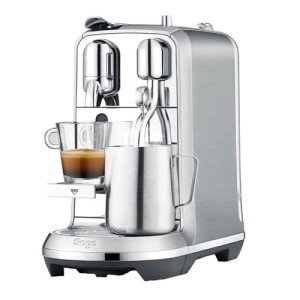Heat Exchange Espresso Machines: A Comprehensive Guide
Espresso machines have actually evolved considerably throughout the years, accommodating the requirements of home baristas and coffee experts alike. Among these machines, heat exchange espresso machines have gained popularity due to their capability to deliver constant performance and remarkable brew quality. In this article, we will explore the functions, advantages, and important functions of heat exchange espresso machines, supplying an extensive understanding for both potential buyers and coffee lovers.
Understanding Heat Exchange Technology
Heat exchange espresso machines operate on a distinct principle that permits simultaneous water heating for developing and steaming. They are geared up with a single boiler that uses a heat exchanger system. This function is substantial as it allows users to brew espresso while steaming milk simultaneously, promoting efficiency in the coffee-making procedure.
How Does a Heat Exchange Espresso Machine Work?
The procedure begins with the machine's water inlet filling the boiler. As the water warms up, it turns to steam. The ingenious heat exchanger utilizes hot steam to heat extra water in a different passage created particularly for the brew group. This suggests that water can reach the perfect brewing temperature level without waiting on the boiler to adjust. The key steps include:
- Water Fill: Water is drawn into the boiler.
- Heating Process: The boiler warms up as water is transformed into steam.
- Heat Exchange: Steam heats up water in the heat exchanger tube.
- Brewing: Water from the heat exchanger is pressed through coffee grounds, drawing out the flavors required for an abundant espresso.
This procedure allows for fast temperature modifications and enhanced coffee extraction.
Advantages of Heat Exchange Espresso Machines
Heat exchange espresso machines provide a number of advantages, especially for those aiming to maximize their coffee experience. Here are some crucial benefits:
- Simultaneous Brewing and Steaming: Users can brew espresso while steaming milk, making it ideal for hectic cafes and home baristas who value effectiveness.
- Temperature Stability: The boiler's steam pressure helps maintain a steady temperature level, which is important for constant espresso extraction.
- Adaptability: The design enables fast switching between developing and steaming, making it simpler to create numerous coffee drinks, from lattes to coffees.
- User-friendly: Models frequently come with accessible controls, making it feasible for both newbies and knowledgeable baristas to produce quality drinks.
- Professional Quality: Heat exchange machines are frequently utilized in commercial settings, offering users with high-quality brewing performance in your home.
Key Features to Look for in Heat Exchange Espresso Machines
When considering the purchase of a heat exchange espresso machine, there are a number of functions that a person should take into account:
- Build Quality: Look for machines made from durable products, such as stainless-steel or brass, ensuring longevity.
- Boiler Size: A bigger boiler will hold more water and sustain greater output in time.
- PID Temperature Control: This feature assists maintain consistent brew temperatures, which can enhance the coffee-making process.
- Group Head Design: Machines with a saturated or semi-saturated group head offer better temperature stability.
- Alleviate of Use: User-friendly user interfaces and intuitive controls boost the general experience for baristas at all ability levels.
- Steam Wand Quality: A good steam wand with correct insulation and flexibility allows for better texturing of milk.
- Water Reservoir Size: Depending on your requirements, think about how frequently you wish to refill the water tank.
Contrast of Popular Heat Exchange Espresso Machines
To much better understand the alternatives readily available in the market, listed below is a contrast table of some popular heat exchange espresso machines:
| Machine Model | Boiler Size | PID Control | Rate Range | User Ratings |
|---|---|---|---|---|
| Profitec Pro 700 | 2.0 L | Yes | ₤ 2,000-₤ 2,500 | 9.5/ 10 |
| Rocket Espresso R58 | 1.8 L | Yes | ₤ 2,400-₤ 2,800 | 9.4/ 10 |
| Elekta Bianca | 1.8 L | Yes | ₤ 2,500-₤ 3,000 | 9.6/ 10 |
| La Spaziale S1 Vivaldi II | 1.5 L | Yes | ₤ 1,800-₤ 2,200 | 9.2/ 10 |
| Bezzera Magica | 1.2 L | No | ₤ 1,600-₤ 1,800 | 9.0/ 10 |
FAQs About Heat Exchange Espresso Machines
What is the primary distinction between a heat exchange and a dual boiler espresso machine?
While both types can brew espresso and steam milk at the very same time, dual boiler machines have different boilers for brewing and steaming. In please click the following webpage , heat exchange machines utilize a single boiler and a heat exchanger to attain the very same function.
Are heat exchange machines appropriate for novices?
Yes! Many heat exchange machines are designed with user-friendly features, making them available for newbies. With view it now and practice, users can rapidly produce quality espresso.
What type of maintenance do heat exchange espresso machines need?
Regular maintenance consists of descaling, cleaning up the boiler, checking seals and gaskets, and keeping the group head tidy. Regular maintenance ensures durability and constant efficiency.
Can I use a heat exchange machine for various kinds of coffee drinks?
Absolutely! Heat exchange machines allow users to produce a range of coffee drinks, including espresso, lattes, cappuccinos, and more.
Heat exchange espresso machines represent a mix of innovation and tradition, offering coffee enthusiasts with the tools required for crafting the ideal cup. Their ability to all at once brew and steam, integrated with exact temperature level control, makes them an engaging choice for both home baristas and professionals. With the best understanding on functions and upkeep, users can unlock a world of exquisite coffee experiences, making sure that each sip is as wonderful as the last.

